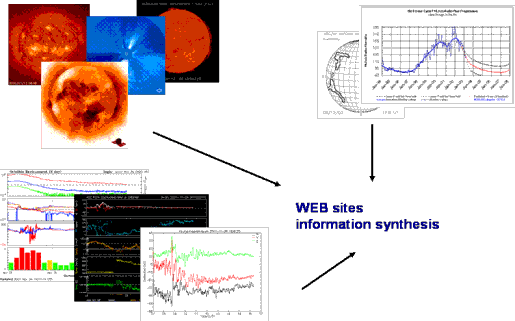| GSP Study Archive |
|---|
| Space Weather Studies |
| Applications Pilot Project |
| Feasibility Studies |
| CDF Space Weather Study |
| Past Workshops |
| Past Publications |

SFC
Solar and geomagnetic activity Forecast Centre
Developer / Operator
CLS
Technical Group
Ionospheric Effects & Activity Forecast
SDA objective
Since January 2000, CLS produces every day estimated and predicted solar activity parameters (F10.7 cm flux, geomagnetic indices).
CLS is member of ISES and SWWT.
Products
Three levels of forecast data are available:
- A daily solar bulletin with forecast and measured indices at www.cls.fr/previsol
- A short time forecast (3 days) with restricted access on the web site www.cls.fr/previsol
- A long time (14 days) forecast available in specific format and only for paying users
To improve our solar activity forecast process, we use new data and model results from CNES R&T studies:
Improvement of F10.7 cm solar flux forecast from the current day to 14 days using Swan/SOHO far side of the Sun data in collaboration with the Laboratoire d'Aéronomie of Verrières le Buisson.
Improvement of Solar flares and CME (coronal mass ejection) probability prediction with the Laboratoire de Physique de l'école Polytechnique: MHD (MagnétoHydroDynamique) modeling for solar flares probability prediction.
Link to Project WebSite
SDA description
The solar activity forecast process consists of 4 principal steps:
- Data reception and collection
- Decoding, processing, tables update
- Forecasting: information synthesis and solar activity prediction
- Files creation and dissemination
The daily forecast is an empirical process. Part of the information is received directly via email and automatically preprocessed (estimated Ap calculation for example), the rest is obtained on web sites of solar missions or instruments, such as SOHO EIT images, ACE measurements, and ground observations (images of the sun, magnetograms,…).
All this information is summarized, analyzed, and leads to a solar activity forecast (10.7 cm flux and geomagnetic indices) for a time interval from the current day to 14 days later.
The long term forecast, more than 6 days, is essentially based on the theory of the 27 day solar cycle. Solar active regions evolution, solar flares and proton events probability forecasts are based on images and past events observations and are short term predicted (2 days).
Contact
Jean-Jacques Valette
| Address: | CLS/DT 8-10, rue Hermès Parc Technologique du Canal 31520 Ramonville St Agne FRANCE |
| E-mail: | valette@cls.fr |
| Telephone: | +330561394762 |
| Telefax: | +330561394806 |
